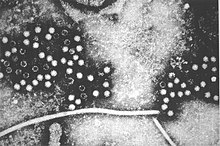User:Mr. Ibrahem/Hepatitis E
| Hepatitis E | |
|---|---|
 | |
| Hepatitis E virus | |
| Specialty | Infectious disease, gastroenterology |
| Symptoms | Tiredness, nausea, pain over liver, jaundice[1] |
| Complications | Cirrhosis, acute liver failure[1] |
| Usual onset | 2 to 10 wks after exposure[2] |
| Duration | 2 to 6 wks[2] |
| Causes | Hepatitis E virus (HEV)[1] |
| Diagnostic method | Blood test[1] |
| Differential diagnosis | Other types of viral hepatitis, leptospirosis, dengue, malaria[2][3] |
| Prevention | Clean water, toilets, vaccination[2] |
| Treatment | Symptomatic care, ribavirin (if chronic)[1] |
| Frequency | 20 million cases per year[2] |
| Deaths | 44,000 (2015)[2] |
Hepatitis E is an infection of the liver by the hepatitis E virus (HEV); it is a type of viral hepatitis.[2][1] Symptoms may include tiredness, nausea, pain over the liver, dark urine, and yellowish skin; though many have no symptoms.[1] Onset of symptoms is generally 2 to 10 weeks after exposure and symptoms last 2 to 6 weeks.[2] Occasionally, in people with a weakened immune system, the infection does not resolve and may result in complications such as cirrhosis.[1] Severe infections, resulting in acute liver failure, may occur in pregnant women.[1]
Hepatitis E is mainly spread by drinking contaminated water; though it may also spread by eating under-cooked meat.[2][1] It does not typically spread directly between people.[1] The virus is a positive-sense, nonenveloped, single-stranded, RNA icosahedral.[3] Diagnosis can be by blood or stool tests.[1] The disease can be separated into 8 genotypes, of which 4 primarily cause disease in people.[4] Other types of viral hepatitis include A, B, C, D, and X.[5]
Prevention is by using clean water and appropriate toilets.[2] A vaccine (HEV 239) is available to prevent the disease in China.[2][6] Treatment is generally symptomatic care including rest and drinking sufficient fluids.[1] Ribavirin may be used for chronic cases.[1] In 2015 it results in about 44,000 deaths.[2] During the third trimester of pregnancy up to 25% of women may die.[2]
In 2017, hepatitis E was estimated to affect more than 19 million people.[7] It occurs more commonly in the developing world, particularly in Asia.[1][2] Males aged 15 to 30 are most commonly affected.[8] It may occur as an outbreak due to poor access to safe water.[2] Outbreaks of hepatitis E date back to at least 1955 in New Delhi.[9] The virus was isolated in 1983 by Russian scientists investigating an outbreak in Afghanistan.[8]
References[edit]
- ^ a b c d e f g h i j k l m n o "Hepatitis (Viral) NIDDK". The National Institute of Diabetes and Digestive and Kidney Diseases. Archived from the original on 2016-12-29. Retrieved 2020-06-19.
- ^ a b c d e f g h i j k l m n o "Hepatitis E". www.who.int. Archived from the original on 20 April 2021. Retrieved 22 May 2021.
- ^ a b Waqar, S; Sharma, B; Koirala, J (January 2021). "Hepatitis E". PMID 30335311.
{{cite journal}}: Cite journal requires|journal=(help) - ^ Dalton, Harry R.; Kamar, Nassim; Baylis, Sally A.; Moradpour, Darius; Wedemeyer, Heiner; Negro, Francesco (June 2018). "EASL Clinical Practice Guidelines on hepatitis E virus infection". Journal of Hepatology. 68 (6): 1256–1271. doi:10.1016/j.jhep.2018.03.005. PMID 29609832. Archived from the original on 2021-08-28. Retrieved 2019-07-27.
- ^ "What Is Viral Hepatitis?". National Institute of Diabetes and Digestive and Kidney Diseases. NIDDK. Archived from the original on 16 April 2021. Retrieved 23 May 2021.
- ^ Li, Shao-Wei; Zhao, Qinjian; Wu, Ting; Chen, Shu; Zhang, Jun; Xia, Ning-Shao (2015-02-25). "The development of a recombinant hepatitis E vaccine HEV 239". Human Vaccines & Immunotherapeutics. 11 (4): 908–914. doi:10.1080/21645515.2015.1008870. ISSN 2164-5515. PMC 4514148. PMID 25714510.
- ^ GBD 2017 Disease Injury Incidence Prevalence Collaborators (10 November 2018). "Global, regional, and national incidence, prevalence, and years lived with disability for 354 diseases and injuries for 195 countries and territories, 1990–2017: a systematic analysis for the Global Burden of Disease Study 2017". Lancet. 392 (10159): 1789–1858. doi:10.1016/S0140-6736(18)32279-7. ISSN 1474-547X. PMC 6227754. PMID 30496104.
{{cite journal}}:|author1=has generic name (help)CS1 maint: numeric names: authors list (link) - ^ a b Izopet, Jacques; Abravanel, Florence; Dalton, Harry R.; Kamar, Nassim (1 January 2014). "Hepatitis E Virus Infection". Clinical Microbiology Reviews. 27 (1): 116–138. doi:10.1128/CMR.00057-13. ISSN 0893-8512. PMC 3910910. PMID 24396139.
- ^ Kumar, Subrat; Subhadra, Subhra; Singh, Bhupinder; Panda, B.K. (April 2013). "Hepatitis E virus: the current scenario". International Journal of Infectious Diseases. 17 (4): e228–e233. doi:10.1016/j.ijid.2012.11.026. ISSN 1201-9712. PMID 23313154. Archived from the original on 2020-09-28. Retrieved 2019-07-27.
